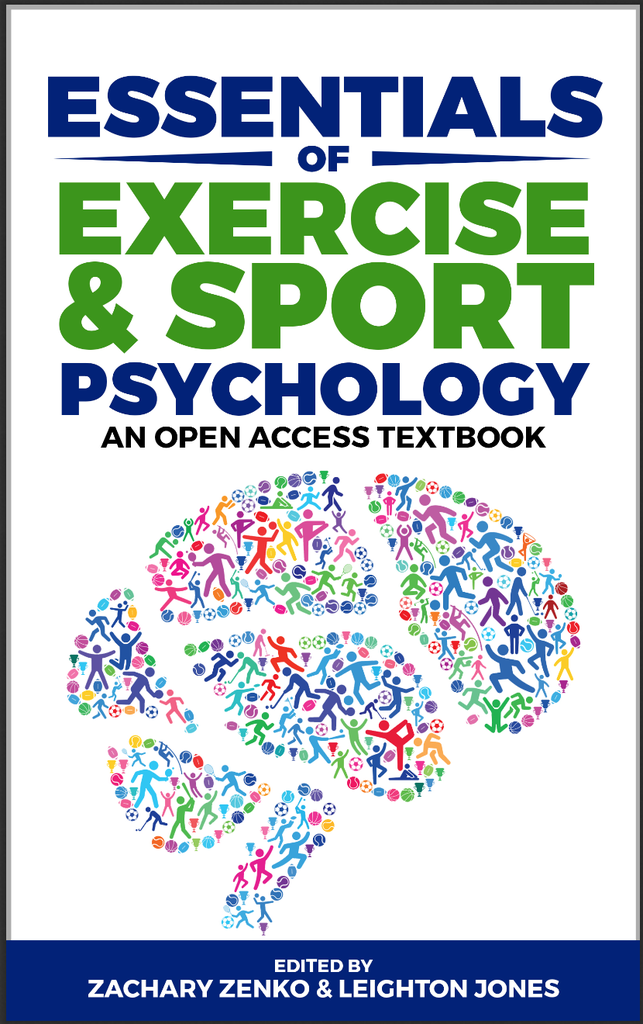Essentials of Exercise and Sport Psychology: An Open Access Textbook
Editorial: Society for Transparency, Openness, and Replication in Kinesiology
Licencia: Creative Commons (by)
Autor(es): Zachary Zenko, Bakersfield, CA
Leighton Jones, Sheffield, UK
Exercise and Sport Psychology investigates the psychological antecedents and consequences of physical activitybehavior. This includes: (a) understanding factors that predispose individuals to avoid or engage in physical activity (e.g., motivation, individual differences); (b) understanding how engagement in physical activity influences an individual’s general well-being (e.g., self-esteem, mental health) throughout the lifespan; and (c) the application of psychological principles to improve athletic well-being and performance (APA Division 47). In such endeavors, the study of Exercise and Sport Psychology intertwines concepts, theories, and knowledge across a wide variety of scientific disciplines (e.g., Sport and Exercise Science, Psychology, Sociology, Neuroscience, Physical Science, and Health Science). Before examining the various perspectives taken by Exercise and Sport Psychology, it is worthwhile to become familiar with some terms related to physical activity. Physical Activityrefers to any bodily movement that results in a substantial increase in caloric (energy) expenditure beyond resting values (ACSM, 2018). Therefore, physical activity refers to numerous types of activities, including household (e.g., vacuuming, car washing, doing laundry), leisure-time (e.g., trail walking, kayaking), transportation (e.g., walking or biking to school/work), and occupational (e.g., heavy lifting, carrying objects) physical activities along with exercise (e.g., running, weight lifting) and sport (e.g., basketball, soccer, boxing). Even though exercise and sport1activities more readily come to mind when considering types of physical activity, they are simply subcomponents of physical activity. Exercise and Sport Psychology, while appearing to be a single area of study by title, are actually considered two distinct content areas, namely Exercise Psychology and Sport Psychology. Exercise Psychologyis concerned with the antecedents and consequences of physical activity behavior (including, but not limited to, exercise). Meanwhile, Sport Psychologyis concerned with psychological principles as they relate to athletes and athletic performance. This chapter will focus on the common goals and approaches of Exercise Psychology, while Sport Psychology will be discussed in more detail elsewhere (see Chapter 19; Hill & Mellano, 2021).While the term “exercise” will be primarily used throughout the rest of this chapter, it should be made clear that the study of Exercise Psychology is interested in all forms of physicalactivity (e.g., household, leisure-time, transportation, occupational, exercise, and sport), not just structured exercise, and is often studied in the context of the general population orspecific subgroups of the population (e.g., individuals with depression, individuals with autism). Research and study in Exercise Psychology is generallydivided into three, broad themes:•Exercise Behavior Promotion:Here priority is given to the influence of internal and external variables as constraints and facilitators to the initiation of, and lifelong adherence to,physical activity behavior.•Dynamic Exercise Psychology:This refers to the basic science of psychological phenomena that occur while engaged in physical activity, or the “state of the mind” and its relation to the body during physical activity.
Compartir:
Una vez que el usuario haya visto al menos un documento, este fragmento será visible.


